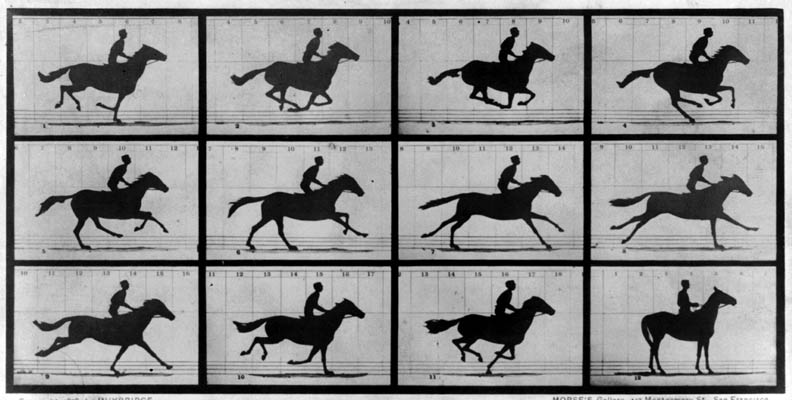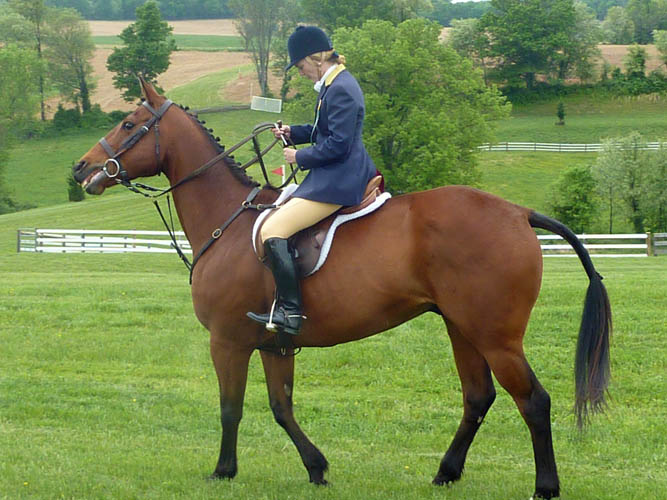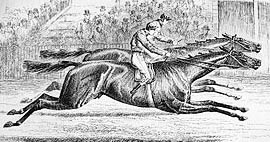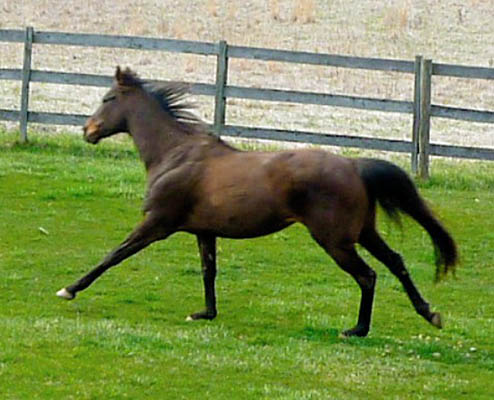So, You Think You Love Horses?
Some Reflections on the Nature of Horses and Man
More Discussions by “The Accidental Horseman”
The Gaits of a Horse
Muybridge's 1878 Pioneering Illustrations of How a Horse Gallops
These were based on high-speed film photos of Leland Stanford's horse "Sallie Gardner"

|
Relaxed Rider at a Walk
At walk the rider can be more relaxed but a smart rider always holds the reins tight. I have been known to daydream, but look at this horse's head and neck and what does it say about the animal's state of mind? One of the important lesions experience teaches is reading the mood of the horse. At the same time the horse reads the rider's mood and this rider says "Nothing to worry about."
|
| 
|
Riders seem to be forever talking about horse’s gaits, and for a person who is not a rider it must seem like a puzzling obsession with what is a trifling matter. It is much like being among a group of New Yorkers who seem to always have these long unfathomable conversions about apartments.
Well, horse’s gaits may not be too important to those on the ground, but when you are up on the back of a sizeable animal it assumes more than a little import. There really are a lot of nuances when it comes to how a horse moves. The first thing to stress is that there are individual differences in any given horse’s manner of moving when compared to any other horse. That is to say that one horse’s walk, trot, canter, gallop, lope, pace, amble, rack or whatever other gait its breeding or training makes it capable of doing, will be a little different from those of its fellow animals, even within a given breed. Even within a given gait there are nuances. For example, when a horse canters it can be on a right or left lead depending on the more extended forelimb that it is leading with during the cycle of limb movements. When going around a curve, it is desirable for a horse to lead with its inside rather than outside legs. Both the horse and rider will enjoy better balance if the horse is on the correct lead during the turn. On a straightaway it does not matter which lead the horse is on, so there is no right and wrong lead to be on. A given horse may feel very different to the rider when on the right lead as opposed to being the left lead when moving straight. So, just like no two people look or sound the same, twins excluded, no two horses move exactly the same. Although we do not make a big deal about it, if we closely analyze people’s gaits I suspect the same holds true, and we can often identify an unseen person walking down a hallway by the sound of their footfalls.
Basic to all animals, both quadrupeds like horses and bipeds like us, is walking. In a horse a walk is a regular four-beat gait. When walking, a horse first advances the left hind leg, followed by the left front leg, then the right hind leg, and finally the right front leg. Each leg moves alone in sequence and the remaining legs are on the ground. At the same time the horse moves its head up and down much like a human moves his arms while walking. The walk is very easy on a horse’s feet and tendons. When turned out horses generally will prefer walking in order to move around. When a horse is walking the rider follows the movement in a slight sway and follows the head movements by moving the reins back and forth so as not to pull on the animal’s month but keep a steady contact with the bit.
A Horrible 19th Century Illustration
At no point in a gallop are a horse's limbs positioned as depicted.

|
|
The next fastest gait, and one that is not shared by all breeds, is the trot. The trot is a two-beat gait in which the horse moves its legs in diagonal pairs. The body of the horse moves up and down as the legs extend, but in this gait the neck is fairly still. Our horses tend to move at a trot when called in to eat unless they are really, really hungry, in which case it sounds like a stampede, and they all arrive at a canter. The problem for the rider is that a trot is springy and if one sits to a trot the rider’s body is bounced up and down. Look at some dressage riders doing sitting trots and they look like Bobbleheads when they allow their heads to be thrown up and down with their bodies. The solution to the problem of sitting to a trot is posting in which a rider allows his body to follow the horse’s movements with a rhythmic rising and sitting in the saddle. Posting at the trot is characteristic of the English riding style while trotting and posting are often avoided in Western riding. Those horses that do not trot often pace. Pacing is also a two-beat gait but pacers move both legs forward on the same side in unison. A slow pace is relatively comfortable to sit to, and in medieval times and prior to the development of posting, pacers were preferred to trotters. However, with a fast pace the rider is thrown rapidly from side to side and quickly becomes uncomfortable if not seasick. The horse itself is a little more stable trotting than pacing in that the diagonal feet being on the ground supports its center of gravity while the pacer’s center of gravity is left dangling in midair. I have been speaking mostly of riding horses astride but the trot and pace are even more significant in a horse in harness. A horse is capable of maintaining these gaits for a fairly prolonged time and a flashy trot or pace is esteemed in a team of driving horses and with the pace gait in harness the ability of a rider to sit to it is beside the point.
Notice diagonal limbs on the ground with extreme flexing of the pastern joint and the extension of the leading foreleg.
|
| 
|
The next and faster gait is the canter, which is common to all horses. However, various styles of riding certain gaited breeds promote training those breeds not to canter under saddle. The canter is a fast, three-beat gait. When listening to the sound one hears three sounds caused by the hoofs striking the ground and then a pause during which the horse is suspended in the air. Depending on the lead, which I mentioned above, one of the horse's rear legs propels the horse forward at the beginning of the cycle. The horse is supported only on that leg while the other three are moving forward. The next sound is generated when the other hind hoof and the contralateral front leg strike the ground, while the original hind hoof is still momentarily on the ground and the other front leg is still momentarily in the air. As the cycle continues the horse catches itself on its other front leg while the diagonal pair mentioned before is momentarily still in contact with the ground and the other lead leg is lifted and moving forward. The sound produced by this is a rhythmic “BA-DA-RUMP—BA-DA-RUMP” as the horse competes the cycle of movements. I love to watch slow motion shots of a horse cantering. Of course, when you are on its back you really cannot see the movements. Even watching on the ground the movements are quick and not easy to follow. Until the development of high-speed photography artists frequently depicted race horse with both pairs of legs extended away from the body. In fact, this never happens, and during the suspension pause the legs are flexed under the horse’s body. These facts were first demonstrated by Eadweard Muybridge in 1878. Sometimes while cantering on a sunny winter day I will steal a glimpse of his shadow against the snow, but a smart rider better keep his eyes forward at a canter across a snowy field, both for his sake and that of the horse. A horse’s leg is a designed as a natural shock absorber. In addition to absorbing the shock of striking the ground, the extension of the muscles and tendons will store kinetic energy and help propel the horse off the ground with the next step.
Three Junior Steeple Chase Riders Racing to the Finish
The first and second riders are in the same phase of the gallop and the third is actively extending in a come-from-behind bid. Notice that both rear legs and the left foreleg are extended but the right foreleg is on the ground. During its time on the ground the body of the horse inscribes an arc as the body of the animal passes over the leg. What the horse is doing is basically vaulting its body over a single leg on the ground.

|
The final common gait is the gallop. This is acknowledged to be the fastest gait of a horse. It may reach speeds of 30-40 miles per hour, but the animal is not able to sustain it for a long time. There is some debate whether or not a gallop is just a faster canter or not. However, the gallop is a four-beat gait while the canter is a three-beat gait so it would seem that they are not the same. The reason for this extra sound is that in the canter one of the hind hooves and the contralateral front hoof strike the ground simultaneous while in the gallop the hind hoof hits the ground a split second before the front hoof as speed increases and this creates the extra sound. However, the legs are moving in the same basic sequence.
The Chestnut Mare Cantering: Suspension Phase
Notice all four legs are clearly shown to be off the ground. In the 19th century they were uncertain if this happened.

|
|
As a beginning rider I was never taught a specific transition between a canter and a gallop exactly. You just urge the horse on from the slower canter and there is this sudden hold-on-to-your-hat burst of speed. You feel the muscles of the horse working under you, and the ground flies by. It is both exhilarating and a little scary. I tend to allow my horse to do this during a straight uphill stretch simply because it is easier to bring him to a halt before you reach the top. My Thoroughbred seems to enjoy running flat out.
There are theoretical physiological limitations on the maximum speed of horses, which of course is of great interest to the racing industry. One major one is breathing. Somewhat like a human swimmer, a horse can only efficiently breathe between strides. Otherwise the chest and abdominal muscles are working against the diaphragm’s movement. The faster a horse goes, the more oxygen its muscles need, but the less time it has to take a breath. Once it reaches the point that it cannot both run faster and also breathe, the only way it can increase the distant it covers is to lengthen its stride. That is to say reach out farther with its limbs. Some of the most famous race horses were also known to have the longest strides. For example, the famous race horse Native Dancer had an unbelievable 29-foot stride while the average stride in race horses is 24.6 feet.
Another factor is the wear and tear on the bones, muscles, and tendons of the legs. Horses evolved as prey animals. The faster horses outran the predators. In a herd of animals it really was that the devil takes the hindmost. Studies have shown that the equine leg design can withstand typical impact forces very well, but there is a point at which these forces exceed nature’s ability and the design fails. This is the sad truth behind these tragic racing injuries horses. These animals truly have a lot of heart and spirit and if you ask them they will race the very wind but there is an upper limit of what their body design can tolerate.
Basic to man’s relationship with a horse is that it is a moving animal. We really do not particularly care if our cats move and with the exception of agility, hunting and racing dogs, often do not care if our dogs move. However, we do care if our horses move. In the case of a horse, its gait is basic to its movement and also to the riding experience of its human companion. I call the rider a companion rather than a passenger because the rider’s role is an active, not a passive one. This is why horse’s gaits are something riders need to fully appreciate. The rider's reward is a sensation unlike any other: to move across the ground at a tremendous speed in partnership with another living creature.
Yours truly,
The Accidental Horseman.
Back to Additional Discussions
Links to Other Sites regarding Horses
Back to Index Page






